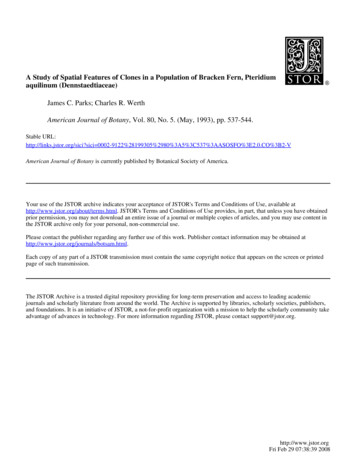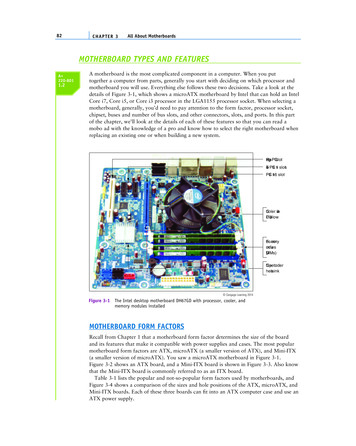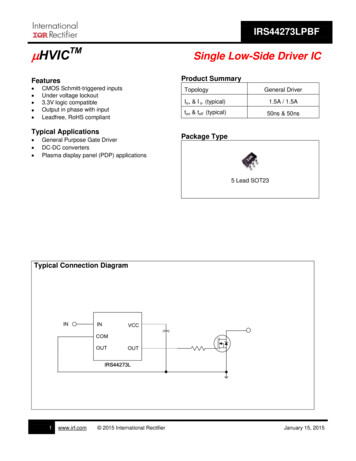
Transcription
A Study of Spatial Features of Clones in a Population of Bracken Fern, Pteridiumaquilinum (Dennstaedtiaceae)James C. Parks; Charles R. WerthAmerican Journal of Botany, Vol. 80, No. 5. (May, 1993), pp. 537-544.Stable URL:http://links.jstor.org/sici?sici O%3B2-VAmerican Journal of Botany is currently published by Botanical Society of America.Your use of the JSTOR archive indicates your acceptance of JSTOR's Terms and Conditions of Use, available athttp://www.jstor.org/about/terms.html. JSTOR's Terms and Conditions of Use provides, in part, that unless you have obtainedprior permission, you may not download an entire issue of a journal or multiple copies of articles, and you may use content inthe JSTOR archive only for your personal, non-commercial use.Please contact the publisher regarding any further use of this work. Publisher contact information may be obtained athttp://www.jstor.org/journals/botsam.html.Each copy of any part of a JSTOR transmission must contain the same copyright notice that appears on the screen or printedpage of such transmission.The JSTOR Archive is a trusted digital repository providing for long-term preservation and access to leading academicjournals and scholarly literature from around the world. The Archive is supported by libraries, scholarly societies, publishers,and foundations. It is an initiative of JSTOR, a not-for-profit organization with a mission to help the scholarly community takeadvantage of advances in technology. For more information regarding JSTOR, please contact support@jstor.org.http://www.jstor.orgFri Feb 29 07:38:39 2008
American Journal of Botany 80(5): 537-544.1993.A STUDY OF SPATIAL FEATURES OF CLONES IN APOPULATION OF BRACKEN FERN, PTERIDIUMAQUILINUM (DENNSTAEDTIACEAE)'Department of Biology, Millersville University, Millersville, Pennsylvania 17551; andDepartment of Biological Sciences, Texas Tech University, Lubbock, Texas 79409Allozymes were used to study the spatial attributes of clones (genets) comprising a population of Pteridium aquilinum(L.) Kuhn var. latiusculum (Desv.) Undenv. ex Heller (bracken fern) in the Appalachian Mountains of Virginia. Ramets(individual leaves) were sampled at intervals of 165 m (or less in some cases) and genotyped for six polymorphic isozymeloci to produce a map depicting the spatial patterning of genets. Forty-five distinct genotypes were detected, 14 of whichwere sampled more than once, five of these more than four times. Genotype proportions at all loci except Pgm-I conformedto Hardy-Weinberg expectations. Estimation of allele frequencies in the population used a "round-robin" approach thatremoved any upward bias for rare alleles that distinguish genets. Based on these allele frequencies, the probability that eachgenotype could arise independently and be sampled was calculated. Some genotypes represented by widely separated rametshad very low probabilities of re-encounter, documenting fragmentation of widespread genets. Coarse-scale mapping indicateda population consisting of many small genets and a few very large ones (up to 1,O15 m across). The larger genets tended tobe irregular in shape, fragmented, and overlapping. Fine scale mapping of individual fronds in spatially discrete patches oframets revealed extensive intergrowth of genets, indicating that P. aquilinum exhibits a "guerrilla-type" clonal morphology.Clonal plants present special problems for analyses ofpopulations because single genetic individuals (genets)may comprise numerous morphological units (ramets)that appear distinct (Silander, 1985a;Maddox et al., 1989).Determinations of population characteristics such as population size, recruitment, mortality, levels of polymorphism, and conformance to Hardy-Weinberg equilibriumall are contingent upon observations on genetically distinct individuals. Thus, it is important to discriminateamong genets in clone-forming species, allowing rametsbelonging to each clone to be recognized and the spatialconfigurations of the clones to be visualized (Cook, 1983).For certain slow-growing perennials, information onclonal extent may be obtained through excavations (Edwards, 1984; Reinartz and Popp, 1987). For a majorityof species, however, genet recognition is facilitated bymolecular markers such as isozymes (Huenneke, 1985;Sheffield, Wolf, and Haufler, 1989; Bayer, 1990; Aspinwall and Christian, 1992; Parker and Hamrick, 1992),DNA fingerprints (Nybom and Schaal, 1990; Turner etal., 1990), or RAPD markers (Smith, Bruhn, and Anderson, 1992). In fact, molecular techniques represent theonly reasonable approach for confident assignment of ramets to genets in rapidly expanding and fragmentingclonal plants.The bracken fern, Pteridium aquilinum (L.) Kuhn, isan aggressive, often weedy species that spreads via rhi-Received for publication 1 May 1992; revision accepted 7 January1993.The authors thank C. H. Haufler for advice on designing the study;M. A. McPeek, D. E. McCauley, and M. D. Willig for assistance withdevelopment of analytical approaches; E. Sheffield and R. Cook forcomments on an early draft of the manuscript; C. H. Haufler and R. J.Bayer for reviews of the paper; and the University of Virginia MountainLake Biological Station for facilitation of field work and isozyme analysis. This research was supported, in part, by Millersville UniversityFaculty Academic Development grants awarded to JCP.Author for correspondence (FAX: 7 17-872-3985).zomes. Because of bracken's importance as a weed it hasbecome the most intensively studied pteridophyte (Smithand Taylor, 1986). The rhizome system of bracken comprises a three-tiered hierarchy, with thick, deep rhizomesconnected to thinner, shallower frond-bearing rhizomesby rhizomes of intermediate thickness (Conway, 1957).Growth rates of as much as 2.1 m in one season havebeen reported (Fletcher and Kirkwood, 1979). Althoughspore-releasingfronds are frequently produced, sexual reproduction of bracken, as evidenced by juvenile sporophytes, is seldom observed in nature (Page, 1976; Wolf,Haufler, and Sheffield, 1988). Thus, bracken populationsare maintained principally by long-lived and rapidlyspreading genets.Various studies have addressed the clonal structure ofpopulations in bracken. Oinonen's (1967) attempts to determine the size of P. aquilinum genets based on morphological features and tracing of rhizomes resulted inunderestimates of clonal size (Sheffield, Wolf, and Haufler, 1989). Although morphological differences amonggenets in a Pteridium population proved inadequate forreliable recognition, recent studies successfully used multilocus allozyme genotypes to establish genet identity.These studies document the great variation in brackenclone size (Sheffield, Wolf, and Haufler, 1989), indicatethat P. aquilinum is an outcrossing, functionally diploidspecies maintaining moderate levels of genetic polymorphism (Wolf, Haufler, and Sheffield, 1987, 1988), andimplicate high levels of gene flow that minimize amongpopulation divergence(Wolf, Sheffield, and Haufler, 1991).The present study also used allozymes to determine infiner detail some spatial features of genets in a southernAppalachian population of P. aquilinum var. latiusculum(Desv.) Undenv. ex Heller. In particular, we sought todetermine the nature of interfaces between genets by examining the genetic composition of dense patches of ramets and to evaluate the extent of genet fragmentationby sampling in two dimensions across a densely colonizedopen area and a more sparsely occupied adjacent forest.
538AMERICAN JOURNAL OF BOTANYAs a corequisite for evaluating clonal extents, an approachwas developed to estimate confidence levels for genetidentity based on allozymes.MATERIALS AND METHODSStudy site-The study area (Fig. 1) is in the vicinity ofthe upper portion of Doe Creek Ravine, near MountainLake Biological Station, Pembroke, Virginia in the ridgeand valley province of the Appalachian Mountains. Thegreater portion of the area is on the WNW-facing slopeof Salt Pond Mountain, which reaches 1,328 m (4,363feet) altitude on the SE edge of the study site; a smallerportion is on the S-facing slope of adjacent BeanfieldMountain. The change in relief from the SW side of thesite is ca. 390 m (1,100 ft). The lower portion of the slopeis cloaked in mixed mesophytic forest which intergradeswith an oak (Quercus spp.), maple (Acer spp.) forest upslope, and a rocky sandstone summit dominated by heaths(Ericaceae). The trees in the mixed mesophytic forest mayexceed 60 cm diameter at breast height (DBH), but theoaks upslope rarely reach 30 cm DBH. Most of the areahas been logged at least once, a portion most recently inthe 1930s. A few charred stumps and old burn scars ontree trunks evidence fire within the last 75 years, but nosigns of recent fires were found on the site.Two electrical transmission line clearings, supportingluxuriant bracken growth, were included in the study area.A smaller line, built in the 1920s, services The MountainLake Hotel at the summit and was the site of intensivesampling. Seven poles, spaced about 100 m apart, wereused as landmarks in this area to mark 100-m x 30-mquadrats numbered I-VII. A wider clearing for a highvoltage line was designated as the southern edge of thestudy area. Two paved roads pass through and intersectwithin the study site: Route 700, originally a pre-CivilWar wagon road, and Route 6 13, a more recent road thatwas unpaved until the mid- 1970s.Robust fronds of P. aquilinum were found in the powerline swaths in discrete, dense clusters (patches)that varied in average width from 0.1 to 30 m. In contrast, frondsin the open oak forest were widely scattered and typicallysmaller. Despite diligent searching, no P. aquilinum wasfound in the dense mixed mesophytic forest NW and SEof the small powerline or S of the large transmission line.Bracken was also excluded by human activity from asizable area between Routes 700 and 613 near their intersection. Bracken extended downslope in both powerlines well below the point where it ceased to occur in theflanking mesic forest, which was apparently unsuitablefor bracken growth. However, in the smaller powerlinethere occurred a 130-m gap with no bracken that includedall of quadrat IV (see Fig. 1).Field sampling- Fronds were chosen for sampling (246in all) using varied strategies for different scales of study.Initial sampling was camed out in 1989 on 34 patchesof bracken within the smaller powerline swath to obtainpreliminary insights into the number and spatial distribution ofgenets. Patches were defined as clusters oframetsfor which no ramet was greater than 2 m distant from apatch member. To determine whether each patch consisted of a single genet (cf. Wolf, Haufler, and Sheffield,[Vol. 801988), one to four fronds, depending on the size of thepatch, were taken from each patch margin.To evaluate fine scale spatial relationships between genets, two patches from powerline quadrat 11, known fromthe preliminary survey to be genetically heterogeneous,were chosen for detailed analysis. The position of everyleaf in these patches was recorded (99 in the larger patchand 20 in the smaller), and allozyme genotypes were determined for a majority of these (79) to determine genetassignment. The relative position of each ramet was thenplotted on a map (Fig. 2).In 1990 a more extensive two-dimensional samplingstrategy was employed to estimate the size and distribution of genets in the wooded area surrounding thepowerline and to maximize the number of genotypesavailable for calculating allele frequencies. After an initialtransect with a 15-m sampling interval yielded only asingle genotype, the sampling interval was increased byan order ofmagnitude. Samples were taken from the frondnearest to transect points at 165-m intervals along compass bearings. Parallel transects, oriented along elevational contours, were separated also by 165 m, resultingin a two-dimensional grid of sample points. The 165-minterval is approximately one-half the sample intervalused by Wolf, Sheffield, and Haufler (1991). The somewhat rugged terrain resulted in some irregularityin placingof sample points, especially in the N and E parts of thestudy area. Each frond sampled was tagged, its positionnoted (along with permanent landmarks such as powerlinepoles and trees), and a small portion ofleaf tissue removedfor electrophoresis. Samples were placed into plastic bags,transported to the laboratory in an insulated container,and kept refrigerated until processing the next day. Subsequently, the position of each sample was plotted (bygenotype number) on a map (Fig. 1).Detection of genotypes-Starch-gel electrophoresis wasused to determine allozyme genotypes for nine enzymesystems coded by 12 scorable loci. Homogenates wereprepared using the pH 7.5 "microbuffer" of Werth (1985)containing 5% polyvinylpyrollidone (mw 40,000) and 1%mercaptoethanol. These were loaded onto 12% starch gelsand electrophoresed. Malate dehydrogenase (MDH),6-phosphogluconate dehydrogenase (6-PGD), isocitratedehydrogenase (IDH), and shikimate dehydrogenase(SKDH) were resolved on the morpholine-citrate buffersystem described in Werth (199 1). Phosphoglucomutase(PGM) and glucose-phosphate isomerase (GPI) were resolved on buffer system 6 of Soltis et al. (1983). Hexokinase (HK), leucine aminopeptidase (LAP), and aspartateamino transferase (AAT) were resolved on the lithiumhydroxide system (Werth, 1985). Staining schedules weresimilar to those of Soltis et al. (1983) but employed the"zymecicle" methodology of Werth (1990). Isozyme bandpatterns corresponded closely to those previously illustrated (Wolf, Haufler, and Sheffield, 1987;Wolf, Sheffield,and Haufler, 1991) and were readily interpreted as diploidgenotypes at individual loci (see Wolf, Haufler, and Sheffield, 1987 for discussion of the ploidy of bracken). Allozymes, and the alleles encoding them, were designatedby numbers with the lowest number representing the mostanodal migration. Allele identity was controlled by running individuals with known genotypes on each gel.
May 19931539PARKS AND WERTH-BRACKEN CLONES38GENOTYPES40629183'Fig. 1. Spatial distribution of genotypes in the Doe Creek, Virginia population of Pteridium aquihnum as based on coarse scale sampling.Genotypes occurring for fewer than four samples are indicated by genotype numbers (see Table 2). Those occurring for four or more samples areindicated by symbols. Narrow and wide electric transmission lines are delimited by dotted and scalloped lines, respectively. The study area iswooded except for roads, powerline clearings, and the shaded portion of the area between the two roads. Bracken is absent or exceedingly rare inareas with no sample points. Poles in small powerline clearing, indicated by " ," mark quadrat boundaries. Quadrats cited in text are indicatedwith Roman numerals.RESULTSPopulation genetic analysis -Sampling for the nine enzymes assayed yielded six consistently scorable polymorphic loci that could be used for genet discriminationat the study site: Hk, Lap, Mdh-2, Pgm-1, Pgm-2, 6-Pgd2. Not all enzymes previously examined in P. aquilinumwere included in the present study; therefore, calculationsof levels of polymorphism or of genetic identities withother populations would be inappropriate. Many of thepolymorphisms encountered in the present study appearcomparable to allele arrays reported for a New Hampshirepopulation of P. aquilinum (Wolf, Sheffield, and Haufler,1991), but no attempt has yet been made to compareallele identities between the two regions.Our sampling of the bracken population resulted indetection of 45 different multilocus isozyme genotypes,each presumably representing at least one separate genet(barring mutation). These were numbered consecutivelyas encountered, although resolution of some initial uncertainties led to some gaps in the numbering sequence.As expected, separate ramets often possessed identicalgenotypes. To evaluate whether these actually representedthe same genet, an approach was developed by CRW toestimate the probability that identical genotypes couldresult from independent formation of zygotes.This approach is conditioned on the following assumptions: 1)each different genotype encountered resultsdirectly from a zygote rather than alteration of an originalgenotype through mutation (while this assumption maynot be entirely valid, it is approximately so, as mutationrates for individual loci are small [Mukai and Cockerham,19771);2) mating is random; and 3) genotypes at separateloci are independent, i.e., loci assort independently andthere is no recombinational disequilibrium among haplotypes. Adherence to assumptions 2 and 3 (violationsmay occur in clonal populations-see Cook, 1983) canbe tested using allozyme data. For example, the assumption of random mating is justified in that the presentbracken population is in Hardy-Weinberg equilibrium(seebelow). Given these assumptions, the probability thata zygote acquires a given diploid genotype, designated
540TABLE1 . Estimates of allele frequencies at six polymorphic loci in theDoe Creek area population of P. aquilinum. Round-robin estimateis based on subsampling as described in text. Unadjusted estimateis based on frequencies of 45 distinct genotypes (see Table 2)Frequency estimateLocus[Vol. 80AMERICAN JOURNAL OF 0380.1890.7670.044Lap1230.1900.7980.0 120.21 10.7780.01 1Mdh-2a0120.01 10.9670.0220.01 10.9670.022Pgm- 1230.1280.3850.4870.1 110.3670.5226-Pgd-21230.5260.05 10.4230.5000.0450.455a Allele "0,"anodal to allele "1," was discovered after allele "1" hadbeen designated.Allele "1" was found in initial screening for polymorphisms thatincluded samples outside the study area, but was never encounteredwithin the study area.p,,, is calculated as the product of locus genotype probabilities, thusPgen (nwhere pi is the frequency in the population of each allele(two per locus) represented in the genotype and h is thenumber of loci that are heterozygous.However, estimation of allele frequencies, which involves tallying allozyme genotypes ofindividuals, is problematic in that these genotypes have been used to determine the separateness of individuals. Circular reasoningemerges when only individuals with different genotypesare entered into the data pool, with the probable resultof overestimating the frequency of rare alleles that wouldmark different genets. This difficulty was circumventedby a subsampling approach. To estimate allele frequenciesat a given locus, all other loci (i.e., excluding the locus inquestion) were used to discern individuals and thus definea subsample of the 45 distinct genotypes. From groupsthat had the same genotype for the subset of loci used,only the first encountered was included in the data pool.Genotypes of individuals comprising the subsample werethen used to calculate allele frequencies for the locus inquestion. This procedure was repeated for each locus ina "round-robin" fashion.Application of -thisround-robin method to the presentbracken data set resulted in exclusion of six individualsfor purposes of calculating Hk-2 allele frequencies, threefor Lap-2, none for Mdh-2, 11 for Pgrn-1, six for Pgrn2, and five for 6-Pgd-2. Allele frequencies determined bythe round-robin method are very similar to those obtainedT L2.E Forty-five distinct multilocus genotypes of Pteridium aquilinum encountered in the study area and their estimated probabilityof 48495052535456No.ofraHk-2 Lap-2 Mdb-2 Pgm-1 Pgm-2 6-Pgd-2 metsProbability ofgenotypeoccurrenceProbabilityof 212230.000040.001920.000560.010930.002230.0003 0.00 1 170.000310.000050.
powerline and to maximize the number of genotypes available for calculating allele frequencies. After an initial transect with a 15-m sampling interval yielded only a single genotype, the sampling interval was increased by an order ofmagnitude. Samples were taken from the frond











